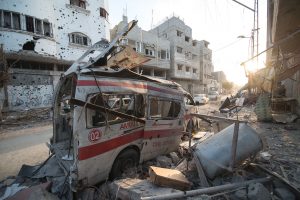Fuelling war and armed violence
Arms are made, bought and sold for fighting and killing, or preparing and threatening to fight and kill. Conflicts cannot be fought without a continual supply of arms, whether sourced within a country, or abroad.
Selling arms to countries in conflict makes conflict more deadly and long lasting. Prior to any actual conflict, arms purchases are likely to increase tensions between or within countries, making actual conflict more likely.
While this may seem obvious, and is backed up by extensive research, it makes no difference to governments such as our own, which continue to promote and sell weapons and fuel violence.

UK arms in conflict zones
It is often difficult to establish where arms used in conflict were produced. However, in several recent cases, UK arms’ use in conflict has been confirmed, or the UK has sold the types of arms to conflict perpetrators that they have been found to have used.
- UK arms have been extensively used in the bombing of Yemen by Saudi Arabia and its coalition allies.
- The UK government admitted that Israeli equipment used in Gaza in the 2008-9 conflict “almost certainly” contained UK-supplied components. The UK has continued to supply similar equipment to Israel since, so it is entirely likely that these were also used in the Israeli wars on Gaza in 2012 and 2014.
- The F-16 combat aircraft used by Turkey to bomb the Kurdish-controlled town of Afrin in Syria in 2018 included laser targetting systems made in the UK.
- The UK sold arms to Libya, both to the Gaddafi regime in the run-up to the 2011 civil war, and very soon after the war, before the outbreak of renewed armed conflict in 2013. Arms sold before 2011 included armoured vehicles, machine guns, small arms ammunition, tear gas and crowd-control ammunition.
- UK arms sales to Egypt in recent years include machine guns and components for combat vehicles, which could easily be used against protesters.
- The UK provides a continual stream of arms to both India and Pakistan, which have fought three wars with each other since independence from the UK and remain in a state of low-level conflict. Both countries are also engaged in severe internal conflicts. India in particular is one of the UK’s biggest arms customers.



